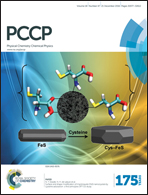Choosing the right precursor for thermal decomposition solution-phase synthesis of iron nanoparticles: tunable dissociation energies of ferrocene derivatives†
Abstract
Organometallic coordination compounds in general and metallocenes in particular are convenient precursors for the synthesis of metal nanoparticles through thermal decomposition. The strength of the interaction between the metal ion and its ligands determines the conditions under which decomposition occurs, most importantly the range of temperatures and pressures at which a given compound is useful as a precursor. We show that a comprehensive analysis of all individual contributions to the ligand metal interactions that establishes the nature of the interaction can be used to select compounds that are tuned to a specific dissociation energy with advantageous properties under experimental conditions. To this end, we apply the Morokuma–Ziegler-Energy Decomposition Analysis (MZ-EDA) to a series of ferrocene analogues using high-level density functional theory (DFT). We find that asymmetrically substituted ferrocene derivatives are unlikely to be useful as precursors because of the large energy required to remove the second cyclopentadienyl-derivative from the central iron atom. However, we are able to establish that symmetrically substituted chloroferrocenes exhibit a wide range of relatively low bond dissociation energies for both dissociation steps and are hence good candidates for the synthesis of highly mono-disperse iron nanoparticles.



 Please wait while we load your content...
Please wait while we load your content...